Pretty Little Pink-eyed Peas and BBQ Across Two States
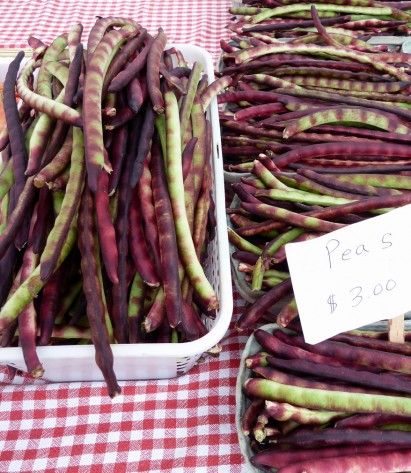
It’s time for Pink-eyed Peas! Pink-eyed Peas! Pink-eyed peas?
Who ever heard of pink-eyed peas? I hadn’t, before taking a trip to Alabama last month, and none of my Northern friends or family members has either. But down south locals are eating them with some smoky, salty pork goodness and, depending on who you talk to, some pepper relish on top and a slice of cornbread on the side.
A variety of cowpeas, this seasonal heat- and drought-tolerant legume, sometimes called “purple hull peas” for the color of its hull, is available fresh throughout much of the summer. My friend Sue, a Northerner whose been living the ’bama life for the last several years, and I discovered them at Birmingham’s Pepper Place Farmer’s Market, hulled and unhulled, and at the ninety-year-old Jefferson County Truck Grower’s Association Farmer’s Market (Birmingham Farmer’s Market, for short), a no-frills market located on the outskirts of town. Produce is sold directly from the back of pick-up trucks—no pretty tabletop merchandising typical of newer farmer’s markets today—with the best prices in town. There we saw a hulling machine making fast work of removing the pretty purple hulls.
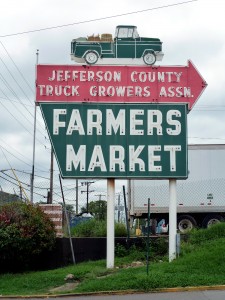
Entrance sign to the decades-old Birmingham Farmer's Market
Following the suggestions of the lady at the farmer’s market who sold us the peas, whose secret ingredient is a touch of honey, and those of Sue’s coworker, Anne Wailes, a native of Birmingham, we prepared these small tender legumes in a classic Southern style, adding our own personal touches of a smidgen of minced garlic and hot sauce. We were so excited to try the peas, I forgot to photograph them. Even though I can’t show you the cooked, creamy colored peas topped with a spoonful of beautiful pepper relish, I can tell you that prepared this way they are delicious, and compared to black-eyed peas, their flavor is more delicate.
How to Prepare Pink-Eyed Peas
Place diced bacon (or some ham hock, tasso ham, etc.) in a pot and cook slowly to render the fat. Add diced onion and cook over medium heat until translucent. (If the bacon you used isn’t sufficiently fatty, you may need to add a little oil when cooking the onion.) Add a touch of minced garlic, if desired, and cook until aromatic (be careful not to burn it), stirring frequently. Add the peas and cover with chicken broth. Add a spoonful of honey and, if desired, a few dashes of hot sauce. Let simmer over very low heat with the lid ajar until tender. Check periodically to make sure the peas remain covered with chicken broth, and add more if necessary. (It’s important that the peas gently simmer to allow them to cook but not bust their outer skins.) Check for doneness after about 20 minutes. When they are just tender, season to taste with salt and pepper, and simmer another few minutes, until done. They will be tender, yet retain a lovely firm texture—they will not be mushy in the least. Serve with pepper relish (recipe follows) and a slice of cornbread.
Catherine Wailes’ Pepper Relish
When Sue and I asked Anne how she prepares pink-eyed peas, she said that topping the cooked peas with a spoonful of pepper relish is a must. To make sure we had the full pink-eyed pea experience, she gave us a jar of her homemade relish, made from a dog-eared recipe handed down from her mother, Catherine. She recalls her mother making this relish almost every summer, working over a hot stove and without air-conditioning, Anne emphasized. This red and green relish adds a nice burst of color to the light-colored peas, and a contrasting sweet-and-sour flavor that perfectly sets off the smoky, meaty peas.
1 dozen green bell peppers
1 dozen red bell peppers
1 dozen medium-size onions
1 bunch celery
2 quarts white vinegar
3 pounds sugar
3 tablespoons canning and pickling salt (kosher salt can be substituted)
Using an old-fashioned, hand-operated tabletop meat grinder or a food processor, grind or finely chop the peppers, onions, and celery to a fairly small size, but not smaller than about ⅛-inch in diameter. (If you grind them too small, the peppers and celery will become mushy; you want to have some texture.) Place the vegetables in a large pot and pour boiling water over them, then drain.
Combine the vinegar and sugar in a large pot and place over medium heat, stirring occasionally. When the sugar is dissolved, add the drained vegetables and salt and bring to a boil. Boil for 10 minutes and place in very hot, sterile jars. (Anne says the combination of the hot relish and hot jars will generate enough heat to create a seal.) The relish will easily keep for a year in a cool, dry place.
Note: Anne hasn’t used a food processor to make the relish, as she prefers the uniformity you get with a meat grinder. Another alternative to a meat grinder is to use a mixer attachment for a KitchenAid stand mixer, which allows you to grind vegetables similarly to a meat grinder.
Variation: Pink-Eyed Peas with Okra
Anne says the combination of pink-eyed peas with tender young okra, about 2 to 3 inches in length, is delicious, and a favorite of hers. To prepare the peas with okra, cook the broth down so it is at the level of the peas or just below. (You will probably want to remove the lid of your pan about mid-way through cooking.) When the peas are tender, lay whole, trimmed okras across the top of the peas and steam, covered, until the okra are tender.
Saw’s BBQ
Another regional specialty, even more regional that pink-eyed peas, though not season-dependent, is smoked chicken, pulled and dressed with “white barbecue sauce,” a mayonnaise-based sauce with a horseradish kick. An Alabamian barbecue specialty, this tradition got it start at Big Bob Gibson Bar-B-Q in Decatur, but is available in other BBQ joints throughout the state. (The recipe for the sauce, invented by Bob Gibson, has not been held under lock and key, thus its spread throughout the state, and it is included among the recipes in Big Bob Gibson’s BBQ Book.)
I sampled it to-go in sandwich form (you can also buy the pulled meat, dressed, by the pound) from my friend Sue and her husband Adam’s favorite neighborhood barbecue establishment: Saw’s BBQ in Homewood, a town just outside Birmingham. (Locals, however, would say that technically Saw’s is in Edgewood, a distinct neighborhood, with its own main street and retail businesses.)
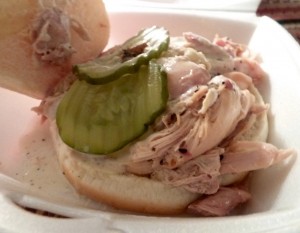
Smoked Chicken with White BBQ Sauce from Saw's
Adam and Sue love the ribs at Saw’s, so, chicken and white sauce aside, that was the main reason we went. The ribs are the best I’ve had: meltingly tender, smoky meat falling off the bone, yet not overcooked or dry, that’s slathered in a Saw’s barbecue sauce—a pefectly balanced vinegar-based sauce with the right touch of chile heat, sweetness, and acid (to cut the unctuous ribs). (Saw’s popular sauce, which took years to develop, is sold at their restaurant and at local stores.)
When we opened our carry-out containers at home, we realized we didn’t have the pulled chicken sandwich in white sauce. The Styrofoam container that we thought contained the sandwich held only the several slices of squared soft, white bread that come with every order of ribs. (Sue and Adam told me that locals use the slices of bread to hold either end of the rib while eating them, and then eat the meat juice and bbq sauce–sopped bread last.)
By the time Sue went back to pick up the missing sandwich, just 15 minutes later, Saw’s had become very busy, with a line out the door. Now that I’ve tried the goods, I can see why Saw’s is so popular.
So how was the smoked chicken sandwich with white barbecue sauce? I’m not one to dis a regional specialty, one that has loyal and passionate adherents. But would I crave it like I would Saw’s ribs with their own, specially developed barbecue sauce? Not ever. Yet it is a lovely sandwich. The meat was very moist and had great smoky flavor, and the sauce was nice and creamy, cooling, tangy, and a bit spicy. (Who doesn’t appreciate a horseradish sauce, after all?). If offered to me, I would never turn my nose up at it. If you’re Alabamian, and grew up eating it, I can see why it would have a special place in your heart. And if you’re not from Alabama, try it.
Holcomb’s Bar-B-Q

Before heading over to Alabama to visit Sue and Adam, I’d spent a few days at my family reunion in a house we rented on Lake Oconee in Georgia, situated midway between the towns of Madison and Greensboro. (We’re not from the area; we pick different places around the country for our reunions.)
Driving through Greensboro on a grocery run, I spotted Holcomb’s Bar-B-Q. Located in a converted gas station with great signage (there are a lot of great signs down south), I decided I had to go. I learned from a local in the market that it’s the best in the area, but is only open Thursday, Friday, Saturday. Luckily I wasn’t leaving Georgia for Alabama until Thursday afternoon.
The menu at Holcomb’s is the simplest I’ve seen at a barbecue restaurant, and it’s highly regional. There are three things on offer: barbecue, coleslaw, and Brunswick stew, a Georgia tradition that was, according to legend, invented in the town of Brunswick. If you count the two ways the meat is available, chopped or sliced, that’s four, plus there are pickles and their delicious homemade vinegar-based bbq sauce (that comes with a slight kick) at the table.

Menu board at Holcomb's
I love that the menu writers at Holcomb’s have assumed you know what “Bar-B-Q” means. I assumed it meant pork, which it does, except at Holcomb’s the part of the pig that is used is the fresh ham, not the butt (or shoulder), which is more typical, or alternatively the entire pig. (According to Buster Davis, III, of the Georgia Barbecue Association, the use of the fresh ham for barbecue isn’t familiar to him. So if you want to try this very special barbecued pork, which is leaner than most, Holcomb’s may be the only place to get it.)
The ham is smoked over hickory, and then chopped or sliced and lightly dressed with their bbq sauce. Their Brunswick stew consists of chicken, pork, corn, and tomatoes; it is, Sandra Holcomb (her father started the restaurant forty years ago) told me, a classic recipe.
Another interesting fact about Holcomb’s: It opens at 9:00 AM, and people do come in, Sandra tells me, for a breakfast of Brunswick stew and barbecue. There is no coffee, however, just ice tea, water, and soft drinks.
Holcomb’s Bar-B-Cue has two locations: the one I went to in Greensboro (phone: 706-453-2577), and the original in White Plains (phone: 706-467-2409). Their homemade barbecue sauce is available for sale at their restaurants.
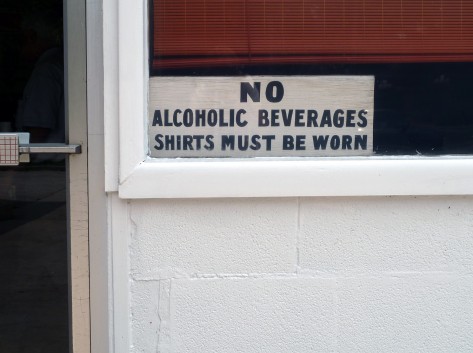
Handmade sign at entrance to Holcomb's
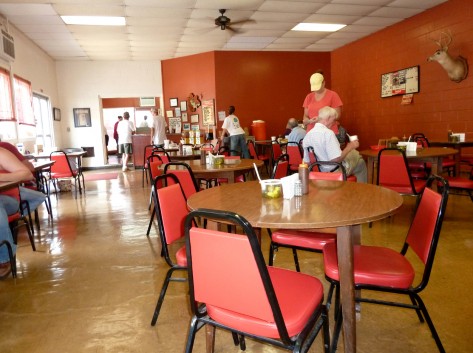
Interior at Holcomb's
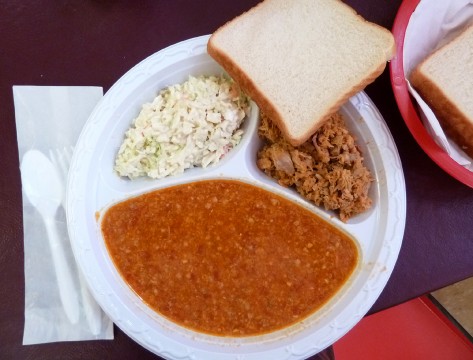
BBQ Plate at Holcomb's: Brunswick stew, coleslaw, and chopped pork
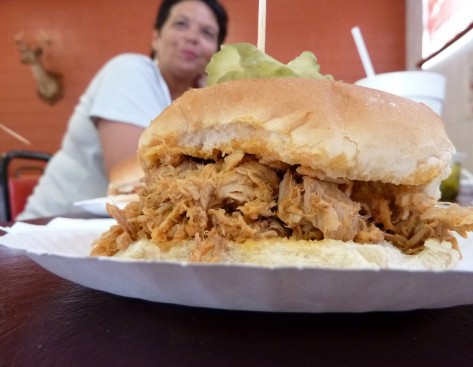
Chopped sandwich at Holcomb's, with cousin Deonna, creator the "Perfect Mac & Cheese" (recipe on this blog), in the background

Take out window at Holcomb's

you are too funny!! Great read.
1Holly, It was fun to see the outcome of the photos you took at Holcomb’s. The chopped sandwich photo is great!
2The details about using the ham portion of the pig were enlightening. It is dinner time. I could use one of those sanwhiches right now. Louanne
Glad you liked it, Deonna. I need to take a trip down your way and experience some of those famous Memphis ribs.
3PS. Thanks for being willing to ham it up for the sandwich photos.
In case you want more recipes for BBQ Pete & I went Lake Charels last week to cater a week-end work BBQ party and this is what we made:
Pulled pork
Total cooking time will be 12 to 14 hours
Brine with brine recipe
1 large pork shoulder/large butt roast or 2 smaller ones (brine for at least 24 hours).
After brined rinse and dry add salt, garlic powder and pepper
Wrap in Heavy-duty foil
(you must add charcoal and to the fire 4 hours, after you open the foil you also add soaked wood chunks)
Cook in foil in a smoker for 8 – 10 hours between 200 and 275 degrees
Then open foil and continue to cook/smoke for the remainder of the time.
(Internal temperature should be 185 degrees upon completion)
Pete’s Guava Glazed Baby Back Ribs
Prepare ribs by removing paper-thin membrane from the rib side. Should peel off. Then Salt and Pepper and Garlic Powder each side. Wrap each rib individually in heavy-duty foil. Wrap them so there is 1″-2″ wide gap that runs the length of the rib. Leave approx. 1″-2″ of foil at each end. Meat side up.
Put on smoker, in-direct heat, for approx 4 hrs or until bones are “loosened”. After the 2nd hour loosen the foil a little and add smoke to taste.
After the initial cook time, remove ribs from foil and brush the Guava B-B-Q sauce on both sides and place back on in-direct heat bone side down. Continue to paint the meat side every 15 min. for approx 2 hrs.
Add smoke to taste. Remove when done and allow to sit for 15 min.
before cutting or eating.
Guava glaze
I bottle of your favorite B-B-Q Sauce in a large Saucepan, Add 6 oz of Guava Jelly, 6 oz of honey and the juice of 1 lemon juice, heat to simmer for 10 minutes.
Pete’s Brine for pork or poultry
This is done 24 hours prior to cooking the Turkey.
1 1/2 cups salt
1 cup Brown Sugar packed firmly
1 tablespoon Garlic Powder
Fresh Garlic 3 cloves crushed, if available.
3 tablespoons any combination of seasonings or dried herbs.
½ teaspoon whole peppercorns
Enough water to cover the bird in a container large enough to handle it (Ice Chest).
1 bag of ice
If you are brining ribs make sure you pull the membrane off the bone side of the ribs.
Allow the meat of choice to soak 24 hours.
Remove and rinse
Deonna’s Cole Slaw
1-cup mayonnaise
2/3 cup granulated sugar
1/2-cup milk
1/2-cup buttermilk
5 tablespoons lime juice
3 tablespoons white vinegar
1-teaspoon salt
1/4-teaspoon pepper
16 cups finely chopped cabbage (about 2 heads)
1/2 cup shredded carrot (2 medium carrot)
8 tablespoons minced onion
1. Be sure cabbage and carrots are chopped up into very fine pieces.
2. Combine the mayonnaise, sugar, milk, buttermilk, lemon juice, vinegar, salt, and pepper in a large bowl and beat until smooth.
3. Add the cabbage, carrots, and onion, and mix well.
4. Cover and refrigerate for at least 2 hours before serving.
Serves 24.
Deonna’s Barbecue Sauce
1-cup water
2 cups ketchup
2 cups tomato sauce
1 1/4 cups brown sugar
1 1/2 cups vinegar
1/2-cup molasses
½ cup yellow mustard
1 large onion grated
4 teaspoons hickory-flavored liquid smoke
2 tablespoons butter
1-teaspoon garlic powder
1-teaspoon onion powder
1/2-teaspoon chili powder
2-teaspoon paprika
1/2-teaspoon celery seed
1/4-teaspoon ground cinnamon
1/2-teaspoon cayenne pepper
1-teaspoon salt
1-tablespoon cumin
2 tablespoons lemon pepper
1 teaspoon coarsely ground black pepper
¼ cup dehydrated onions
1 tablespoon minced garlic
Pour all ingredients into a medium saucepan and heat over medium heat. Once it comes to a boil, reduce heat to low and simmer for 1 ½ to 2 hours, depending on how thick you want the sauce. Sauce can also be thinned using a bit of water if necessary. Brush sauce onto any kind of meat or poultry during the last 10 minutes of cooking or use straight as bbq sauce for dipping.
Deonna’s BBQ baked beans
4(makes 2 large pans)
½ cup ketchup
½ cup mustard
1 ½ cups brown sugar
½ cup molasses
2 teaspoons lemon pepper
2 tablespoons cumin
1-teaspoon salt
1-teaspoon ground pepper
1-tablespoon paprika
1 pkg bacon cooked and crumbled
¼ cup bacon grease (from above)
3 cans pinto beans drained not rinsed
3 cans navy beans drained not rinsed
2 cans black beans drained not rinsed
2 cans kidney beans drained not rinsed
1 can rotel
2 cans stewed tomatoes drained not rinsed
1 yellow pepper diced
1 orange pepper diced
1 red pepper diced
1 large onion diced
1 tablespoon minced garlic
Mix all together and place into 2 pans, you can cook at either 350 Degrees for 90 minutes or 200 degrees for 3 hours (place on cookie sheet to prevent spillover in oven).
Thanks Deonna for sharing your great-looking recipes. You’re very generous. Plus I learned about Rotel. -H
5Holly, I enjoyed your article on Holcomb’s. My grandfather started the restaurant forty years ago, and it has been more successful than he could have ever imagined. I wish he was here to see his restaurant mentioned in Southern Living and bon appetit magazines.
We hope to see you again soon!
6Jessye, I’m so glad you found my story. I truly enjoyed my visit to Holcomb’s and will come back the next time I’m within a hundred miles of it, or more. I doubt your grandfather would have imagined that Holcomb’s would have been featured in national food magazines, either. How wonderful.
7